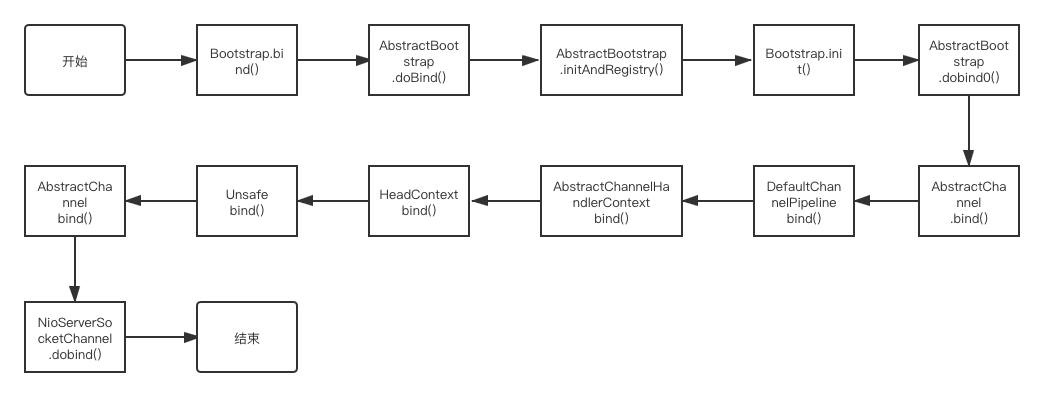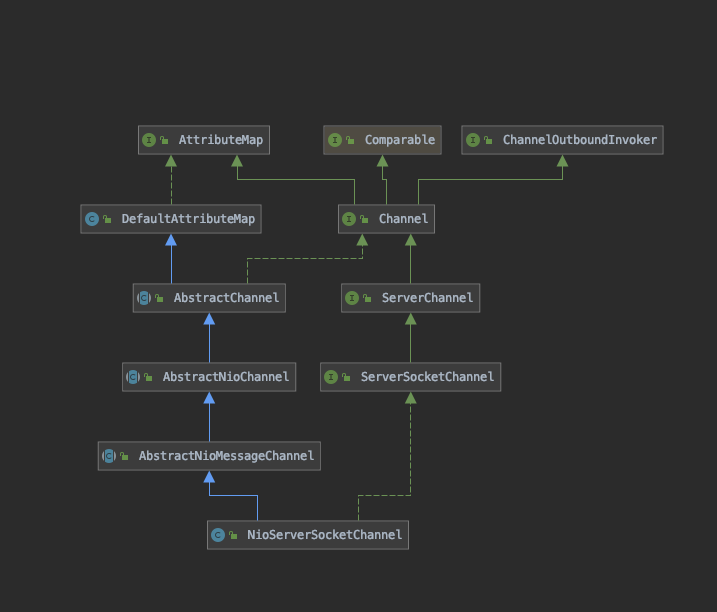ServerBootstrap监听端口
接下来带他们通过源码去分析下ServerBootstrap是如何监听端口

源码分析
1. 先看一下启动demo
EventLoopGroup bossGroup = new NioEventLoopGroup(1);
EventLoopGroup workerGroup = new NioEventLoopGroup();
ServerBootstrap b = new ServerBootstrap();
b.group(bossGroup, workerGroup)
.channel(NioServerSocketChannel.class)
.option(ChannelOption.SO_BACKLOG, 100)
.handler(new LoggingHandler(LogLevel.INFO))
.childHandler(new ChannelInitializer<SocketChannel>() {
@Override
public void initChannel(SocketChannel ch) throws Exception {
ChannelPipeline p = ch.pipeline();
if (sslCtx != null) {
p.addLast(sslCtx.newHandler(ch.alloc()));
}
//p.addLast(new LoggingHandler(LogLevel.INFO));
p.addLast(serverHandler);
}
});
// Start the server.
ChannelFuture f = b.bind(PORT).sync();
2. ServerBootstrap.bind(PORT)
首先从ServerBootstrap.bind(PORT)入手,开始看下他是如何去监听端口,完成Nio底层的一些封装。直接看其抽象类AbstractBootstrap的方法实现
private ChannelFuture doBind(final SocketAddress localAddress) {
final ChannelFuture regFuture = initAndRegister(); // 初始化并且去注册channel
final Channel channel = regFuture.channel();
if (regFuture.cause() != null) {
return regFuture;
}
if (regFuture.isDone()) {
// At this point we know that the registration was complete and successful.
ChannelPromise promise = channel.newPromise();
doBind0(regFuture, channel, localAddress, promise);
return promise;
} else {
// Registration future is almost always fulfilled already, but just in case it's not.
final PendingRegistrationPromise promise = new PendingRegistrationPromise(channel);
regFuture.addListener(new ChannelFutureListener() {
@Override
public void operationComplete(ChannelFuture future) throws Exception {
Throwable cause = future.cause();
if (cause != null) {
// Registration on the EventLoop failed so fail the ChannelPromise directly to not cause an
// IllegalStateException once we try to access the EventLoop of the Channel.
promise.setFailure(cause);
} else {
// Registration was successful, so set the correct executor to use.
// See https://github.com/netty/netty/issues/2586
promise.registered();
doBind0(regFuture, channel, localAddress, promise);
}
}
});
return promise;
}
}
3. 我们先分析下initAndRegister()到底干了什么?
final ChannelFuture initAndRegister() {
Channel channel = null;
try {
channel = channelFactory.newChannel(); // 这边是ReflectiveChannelFactory类通过反射去创建我们初始化bootstrap设置的Channel,这里由于我们是服务端,那就是NioServerSocketChannel
init(channel);
} catch (Throwable t) {
if (channel != null) {
// channel can be null if newChannel crashed (eg SocketException("too many open files"))
channel.unsafe().closeForcibly();
// as the Channel is not registered yet we need to force the usage of the GlobalEventExecutor
return new DefaultChannelPromise(channel, GlobalEventExecutor.INSTANCE).setFailure(t);
}
// as the Channel is not registered yet we need to force the usage of the GlobalEventExecutor
return new DefaultChannelPromise(new FailedChannel(), GlobalEventExecutor.INSTANCE).setFailure(t);
}
ChannelFuture regFuture = config().group().register(channel);
if (regFuture.cause() != null) {
if (channel.isRegistered()) {
channel.close();
} else {
channel.unsafe().closeForcibly();
}
}
// If we are here and the promise is not failed, it's one of the following cases:
// 1) If we attempted registration from the event loop, the registration has been completed at this point.
// i.e. It's safe to attempt bind() or connect() now because the channel has been registered.
// 2) If we attempted registration from the other thread, the registration request has been successfully
// added to the event loop's task queue for later execution.
// i.e. It's safe to attempt bind() or connect() now:
// because bind() or connect() will be executed *after* the scheduled registration task is executed
// because register(), bind(), and connect() are all bound to the same thread.
return regFuture;
}
4. ServerBootstrap类 init方法
分析一下这个init(channel)干了什么
void init(Channel channel) {
setChannelOptions(channel, newOptionsArray(), logger); // 设置channelOptions
setAttributes(channel, newAttributesArray());// 设置Attributes
ChannelPipeline p = channel.pipeline();
final EventLoopGroup currentChildGroup = childGroup;
final ChannelHandler currentChildHandler = childHandler;
final Entry<ChannelOption<?>, Object>[] currentChildOptions = newOptionsArray(childOptions);
final Entry<AttributeKey<?>, Object>[] currentChildAttrs = newAttributesArray(childAttrs);
// 往ChannelPipeline添加了一个ChannelInitializer,此时channelPipeline里结构为。Head-> ChannelInitializer -> Tail
p.addLast(new ChannelInitializer <Channel>() {
@Override
public void initChannel(final Channel ch) {
final ChannelPipeline pipeline = ch.pipeline();
ChannelHandler handler = config.handler();
if (handler != null) {
pipeline.addLast(handler);
}
ch.eventLoop().execute(new Runnable() {
@Override
public void run() {
pipeline.addLast(new ServerBootstrapAcceptor(
ch, currentChildGroup, currentChildHandler, currentChildOptions, currentChildAttrs));
}
});
}
});
}
总结一下 init大致就是设置一些配置属性以及添加了一个ChannelInitializer,这个ChannelInitializer看他的方法好像是设置一个ServerBootstrapAcceptor,具体哪里执行这个ChannelInitializer不清楚,带着疑惑我们继续往下看。
5. MultithreadEventLoopGroup类 register方法
回到步骤3我们看下这行代码
ChannelFuture regFuture = config().group().register(channel);
config().group() 这个代码就是通过ServerBootstrapConfig的group()方法去获取我们设置的NioEventLoopGroup(boss线程)
NioEventLoopGroup类的register方法在父类MultithreadEventLoopGroup中实现:
@Override
public ChannelFuture register(Channel channel) {
return next().register(channel);
}
MultithreadEventLoopGroup 种next()返回的实例是 SingleThreadEventLoop,因此我们直接看SingleThreadEventLoop的registry方法,通过方法的调用链路最终找到下面这个方法:
@Deprecated
@Override
public ChannelFuture register(final Channel channel, final ChannelPromise promise) {
ObjectUtil.checkNotNull(promise, "promise");
ObjectUtil.checkNotNull(channel, "channel");
channel.unsafe().register(this, promise);
return promise;
}
这下出来了一个新的东西 channel.unsafe(),我们先分析下这个东西返回的是什么,因为我们知道我们的channel是NioServerSocketChannel,所以我们直接去看NioServerSocketChannel的unsafe()方法:
AbstractNioChannel.unsafe() -> AbstractChannel的unsafe变量 -> AbstractNioMessageChannel.newUnsafe()
最终我们可以确定返回的是NioMessageUnsafe;
那我直接看NioMessageUnsafe的register方法,这个方法是在父类AbstractUnsafe中定义
@Override
public final void register(EventLoop eventLoop, final ChannelPromise promise) {
ObjectUtil.checkNotNull(eventLoop, "eventLoop");
if (isRegistered()) {
promise.setFailure(new IllegalStateException("registered to an event loop already"));
return;
}
if (!isCompatible(eventLoop)) {
promise.setFailure(
new IllegalStateException("incompatible event loop type: " + eventLoop.getClass().getName()));
return;
}
// 将NioServerSocketChannel的eventLoop 绑定到 MultithreadEventLoopGroup的next()返回的eventLoop
AbstractChannel.this.eventLoop = eventLoop;
// 如果当前线程是eventLoop则直接执行
if (eventLoop.inEventLoop()) {
register0(promise);
} else {
try {
// 提交一个eventLoop任务,任务会在EventLoop线程启动后去之行,下面会讲EventLoop线程是如何启动的
eventLoop.execute(new Runnable() {
@Override
public void run() {
register0(promise);
}
});
} catch (Throwable t) {
logger.warn(
"Force-closing a channel whose registration task was not accepted by an event loop: {}",
AbstractChannel.this, t);
closeForcibly();
closeFuture.setClosed();
safeSetFailure(promise, t);
}
}
}
继续看下AbstractUnsafe的register0方法,(此方法不是立马执行,而是等EventLoop线程启动之后,这边可以顺便分许下这个方法)
private void register0(ChannelPromise promise) {
try {
//代码省略
doRegister(); // 开始注册,由外部类AbstractChannel实现
} catch (Throwable t) {
// Close the channel directly to avoid FD leak.
closeForcibly();
closeFuture.setClosed();
safeSetFailure(promise, t);
}
//代码省略
if (isActive()) {
if (firstRegistration) {
// 第一次注册通过处罚ChannelActive事件
pipeline.fireChannelActive();
} else if (config().isAutoRead()) {
// 设置感兴趣的事件
beginRead();
}
}
}

由上图我们找到doRegister方法在AbstractNioChannel中实现,AbstractChannel里仅仅是个空实现,
@Override
protected void doRegister() throws Exception {
boolean selected = false;
for (;;) {
try {
// 注册java的ServerSocketChannel到EventLoop的Selector上去,并且把当前的netty的channel绑定到java的attachment上去,第二次参数0代表不订阅事件
selectionKey = javaChannel().register(eventLoop().unwrappedSelector(), 0, this);
return;
} catch (CancelledKeyException e) {
if (!selected) {
// Force the Selector to select now as the "canceled" SelectionKey may still be
// cached and not removed because no Select.select(..) operation was called yet.
eventLoop().selectNow();
selected = true;
} else {
// We forced a select operation on the selector before but the SelectionKey is still cached
// for whatever reason. JDK bug ?
throw e;
}
}
}
}
- 这边注册完成后但是没有完成Accept事件的注册,我们继续研究下是怎么完成Accept事件的注册,通过代码我们得知如果不是第一次注册直接调用AbstractChannel的beginRead()->AbstractNioChannel的doBeginRead(),然后完成注册,
- 第一次调用的话是通过PipeLine触发ChannelActive事件 ,然后调用HeadContext的channelActive方法,然后调用readIfIsAutoRead方法
// Channel.read() or ChannelHandlerContext.read() was called
final SelectionKey selectionKey = this.selectionKey;
if (!selectionKey.isValid()) {
return;
}
readPending = true;
final int interestOps = selectionKey.interestOps();
if ((interestOps & readInterestOp) == 0) {
selectionKey.interestOps(interestOps | readInterestOp);
}
NioSeverSocketChannel在新建时候初始化到父类AbstractNioChannel是一个SelectionKey.OP_ACCEPT事件,因此这边完成的是连接事件的监听
public NioServerSocketChannel(ServerSocketChannel channel) {
super(null, channel, SelectionKey.OP_ACCEPT);
config = new NioServerSocketChannelConfig(this, javaChannel().socket());
}
protected AbstractNioChannel(Channel parent, SelectableChannel ch, int readInterestOp) {
super(parent);
this.ch = ch;
this.readInterestOp = readInterestOp;
try {
ch.configureBlocking(false);
} catch (IOException e) {
try {
ch.close();
} catch (IOException e2) {
if (logger.isWarnEnabled()) {
logger.warn(
"Failed to close a partially initialized socket.", e2);
}
}
throw new ChannelException("Failed to enter non-blocking mode.", e);
}
}
到这里完成了nio ServerSocketChannel selector的注册,
6. EventLoop类 run方法
看到这里有同学有疑问,这个提交任务,但是没有看到哪里启动了EventLoop的线程?带着这个疑惑我们看下eventLoop的execute方法。
@Override
public void execute(Runnable task) {
ObjectUtil.checkNotNull(task, "task");
execute(task, !(task instanceof LazyRunnable) && wakesUpForTask(task));
}
private void execute(Runnable task, boolean immediate) {
boolean inEventLoop = inEventLoop(); // 判断是不是当前EventLoop线程
addTask(task); // 提交job
if (!inEventLoop) { //如果不是在EventLoop线程中
startThread(); // 这个是开启线程吗?下面我会给分析下这个代码
// 移除job的一些操作
if (isShutdown()) {
boolean reject = false;
try {
if (removeTask(task)) {
reject = true;
}
} catch (UnsupportedOperationException e) {
// The task queue does not support removal so the best thing we can do is to just move on and
// hope we will be able to pick-up the task before its completely terminated.
// In worst case we will log on termination.
}
if (reject) {
reject();
}
}
}
if (!addTaskWakesUp && immediate) {
wakeup(inEventLoop);
}
}
SingleThreadEventExecutor的startThread()这个方法是开启EventLoop的线程(如果线程没有启动的话)
private void startThread() {
if (state == ST_NOT_STARTED) {
// cas判断下避免多线程开启线程,
if (STATE_UPDATER.compareAndSet(this, ST_NOT_STARTED, ST_STARTED)) {
boolean success = false;
try {
// 开启当前的EventLoop
doStartThread();
success = true;
} finally {
if (!success) {
STATE_UPDATER.compareAndSet(this, ST_STARTED, ST_NOT_STARTED);
}
}
}
}
}
SingleThreadEventExecutor的doStartThread()方法
private void doStartThread() {
assert thread == null;
executor.execute(new Runnable() {
@Override
public void run() {
// 其他代码省略。。。
SingleThreadEventExecutor.this.run();
// 其他代码省略。。。
}
});
}
接下来我们直接看 SingleThreadEventExecutor.this.run()这个方法,其运行的是子类NioEventLoop类中的run方法:
@Override
protected void run() {
int selectCnt = 0;
for (;;) {
//代码省略 这里面大致就是处理IO事件 以及 自定义Job事件
}
}
7. ServerBootstrap类 doBind0方法
通过下面我们可以看到,此时像EventLoop线程池中提交了一个Runnable,里面会调用channel.bind(localAddress, promise)去绑定端口
private static void doBind0(
final ChannelFuture regFuture, final Channel channel,
final SocketAddress localAddress, final ChannelPromise promise) {
// This method is invoked before channelRegistered() is triggered. Give user handlers a chance to set up
// the pipeline in its channelRegistered() implementation.
channel.eventLoop().execute(new Runnable() {
@Override
public void run() {
if (regFuture.isSuccess()) {
// 绑定ip端口逻辑
channel.bind(localAddress, promise).addListener(ChannelFutureListener.CLOSE_ON_FAILURE);
} else {
promise.setFailure(regFuture.cause());
}
}
});
}
那我们直接来看下channel.bind(localAddress, promise)具体看了什么,因为是服务端我们知道channel是NioServerSocketChannel,那我们去这里面寻找答案,果然在里面找到了最关键的一个方法,调用了pipeline的bind方法。pipeline默认是DefaultChannelPipeline
@Override
public ChannelFuture bind(SocketAddress localAddress, ChannelPromise promise) {
return pipeline.bind(localAddress, promise);
}
我们继续往下看DefaultChannelPipeline的bind方法,调用了Tail节点的bind方法,然后往Head节点传播
@Override
public final ChannelFuture bind(SocketAddress localAddress, ChannelPromise promise) {
// 调用tail节点的bind
return tail.bind(localAddress, promise);
}
tail的bind方法定义在其父类AbstractChannelHandlerContext中
@Override
public ChannelFuture bind(final SocketAddress localAddress, final ChannelPromise promise) {
ObjectUtil.checkNotNull(localAddress, "localAddress");
if (isNotValidPromise(promise, false)) {
// cancelled
return promise;
}
final AbstractChannelHandlerContext next = findContextOutbound(MASK_BIND);
EventExecutor executor = next.executor();
if (executor.inEventLoop()) {
next.invokeBind(localAddress, promise);
} else {
// 提交job,最终会被EventLoop执行
safeExecute(executor, new Runnable() {
@Override
public void run() {
next.invokeBind(localAddress, promise);
}
}, promise, null, false);
}
return promise;
}
这时候我们发现又是提交了一个Runnable去调用下一个的invokeBind方法
private void invokeBind(SocketAddress localAddress, ChannelPromise promise) {
if (invokeHandler()) {
try {
// 这行实际调用的是Header节点中的bind(this, localAddress, promise)
((ChannelOutboundHandler) handler()).bind()(this, localAddress, promise);
} catch (Throwable t) {
notifyOutboundHandlerException(t, promise);
}
} else {
bind(localAddress, promise);
}
}
直接看HeadContext中的实现方法
@Override
public void bind(
ChannelHandlerContext ctx, SocketAddress localAddress, ChannelPromise promise) {
// 这个unsafe是NioServerScoketChannel中产生的
unsafe.bind(localAddress, promise);
}
分析代码在其方法里找到了AbstractUnsafe类最终调用的外部类(NioServerScoketChannel)doBind方法,我们得知道NioServerScoketChannel中肯定存在doBind方法的实现l类
@Override
public final void bind(final SocketAddress localAddress, final ChannelPromise promise) {
assertEventLoop();
// 代码省略
try {
//核心代码出现,
doBind(localAddress);
} catch (Throwable t) {
safeSetFailure(promise, t);
closeIfClosed();
return;
}
// 代码省略
}
NioServerScoketChannel的doBind方法
@SuppressJava6Requirement(reason = "Usage guarded by java version check")
@Override
protected void doBind(SocketAddress localAddress) throws Exception {
//获取java的channel然后开始绑定端口
if (PlatformDependent.javaVersion() >= 7) {
javaChannel().bind(localAddress, config.getBacklog());
} else {
javaChannel().socket().bind(localAddress, config.getBacklog());
}
}
综上自此完成端口的绑定
总结一下
根据以上源码分析,我们大致能够清晰看到Netty是如何去封装服务端的端口绑定,下面我们总结下主要流程
- 初始化netty channel,设置一些属性,初始化pipeline等操作
- 注册channel
- 绑定channel设置EventLoop
- 将初始化的java channel绑定到EventLoop的selector上
- 启动EventLoop的run方法,用于处理Io事件
- pipeline触发fireChannelActive注册Accept事件
- 执行bind方法,
结束
识别下方二维码!回复:
入群,扫码加入我们交流群!

